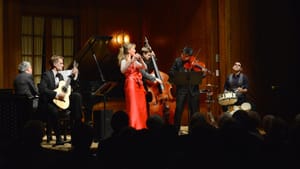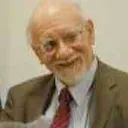Stay in the Loop
BSR publishes on a weekly schedule, with an email newsletter every Wednesday and Thursday morning. There’s no paywall, and subscribing is always free.
Celebrating a phenomenon
Dolce Suono's 10th-anniversary celebration

Dolce Suono concerts always remind me of one of the great ideas of my favorite Italian philosopher: A prince is known by the men around him. The dynamo at Dolce Suono’s core, flutist Mimi Stillman, has a knack for attracting first-class musicians. For her program celebrating the opening of Dolce Suono’s 10th season, she enlisted some of the best regulars and guests on the Dolce Suono roster and constructed a variety show that sampled the range and unpredictable diversity of the concerts her creation has presented in the last nine years.
The two pieces that featured mezzo Misoon Ghim were a good example of the diversity and ability on display. Ghim sang the opening aria by Handel in a true Baroque style, with all the ornaments, such as long trills, that make Baroque vocal music exciting and emotionally effective. Then, a few minutes later, she sang three of Manuel Valls’s 20th-century versions of Spanish Sephardic songs, two with a soaring medieval troubadour style, and the finale with a lively, hip-swinging rhythm.
To anyone familiar with the Philadelphia music scene, the lineup for Poulenc’s Sextet for Winds and Strings looked like a Marvel Comics superhero gang. The Philadelphians included Philadelphia Orchestra horn player Shelley Showers; the Chamber Orchestra’s principal oboe, Geoffrey Deemer; and one of Philadelphia’s leading chamber pianists, Charles Abramovic. The out-of-town guests were both wind players with national reputations: clarinetist Anthony McGill from the New York Philharmonic and bassoonist Harrison Hollingsworth of the New York City Ballet. Mimi Stillman, of course, worked the flute position.
Life in the big city
The result was a rousing performance of one of the great chamber works of the 20th century. Composed in 1936, Poulenc’s jazzy, poetic portrait of urban life traverses all the moods of the mid-century city, from the clatter of street life to late night barroom broods and the more benign moods associated with Sunday brunches and popular parks.
Most of the musicians on the program were established figures with whom Stillman has worked for years, but she is still spotting new talent. Two of the string players spotlighted in the first movement of a Fauré quartet for piano and strings are still Curtis students: cellist Arlen Hlusko and violist Born Lau. The third, violinist Yiying Julia Li, joined the Philadelphia Orchestra in January of this year.
I would normally object to a single-movement excerpt from a longer work, but the whole Fauré quartet couldn’t be included in a program that emphasized variety. The opening movement was a good choice. It’s marked allegro, but it contained moving slow passages and beautiful moments for all three string players and pianist Amy Yang.
Flirtation by a river
The opening number in the second half, Schubert’s Shepherd on the Rock, included a display of understated artistry from another guest with a national reputation, pianist Natalie Zhu. The dialogue between Sarah Shafer’s eloquent soprano and McGill’s equally eloquent clarinet forms the center of attention in Schubert’s song setting, but Zhu's unobtrusive keyboard work placed them in a landscape. The piano murmured like a river in the opening sections and created a suggestion of an oompah band playing in the background as the two principals completed their flirtation.
The second half continued the first half’s leaps through time and space, following Schubert’s early 19th-century German lieder with a happy ragtime interlude by Jelly Roll Morton, a stop at Rio’s Aeroporto do Galeao with Brazilian composer Altamiro Carrilho, and a tango finale by the apostle of the tango, Astor Piazzolla.
Party time
I’m not a ragtime buff, so I don’t know how the Jelly Roll Morton would have sounded to a connoisseur of the form. I can only report that it bounced and raced and generally made you feel like you’d joined a party that would end with whiskey and barbecue. Piazzolla’s tangos have become one of Mimi Stillman’s specialties, and this was one of Dolce Suono’s best — a visit to a fantasy version of an Argentine nightclub.
The complement for the ragtime and tango interludes included three other musicians who’ve been added to the Dolce Suono roster in the last couple of years — guitarist Gideon Whitehead, percussionist Gabriel Globus-Hoenich, and double-bass Robin Kesselman (who recently signed a six-month contract while continuing his studies at Curtis). Dolce Suono has obviously showcased a remarkable flutist, but it has also created opportunities for a group of musicians who have been selected with care and knowledgeable discernment — and given the rest of us more opportunities to hear them. Machiavelli knew what he was talking about.
What, When, Where
Dolce Suono Ensemble, 10th Anniversary Celebration Concert: Handel, “Dopo notte.” Fauré, Allegro from Piano Quartet #2 in G Minor. Valls, Canciones Sefarditas. Poulenc, Sextet for Winds and Strings. Schubert, Der Hirt auf dem Felsen. Morton, The Pearls, Shreveport Stomp. Carrilho, Aeroporto do Galeao. Piazzolla, Libertango. Sarah Shafer, soprano. Misoon Ghim, mezzo-soprano. Mimi Stillman, flute. Geoffrey Deemer, oboe. Anthony McGill, clarinet. Harrison Hollingsworth, bassoon. Shelley Showers, horn. Yiying Julia Li, violin. Born Lau, viola. Arlen Hlusko, cello. Robin Kesselman, double bass. Charles Abramovic, piano. Amy Yang, piano. Natalie Zhu, piano. Gideon Whitehead, guitar. Gabriel Globus-Hoenich, percussion. Mimi Stillman, Artistic Director.
October 12, 2014 at Field Concert Hall, Curtis Institute of Music, 18th and Locust Streets, Philadelphia. 267-252-1803 or www.dolcesuono.com.
Sign up for our newsletter
All of the week's new articles, all in one place. Sign up for the free weekly BSR newsletters, and don't miss a conversation.
 Tom Purdom
Tom Purdom